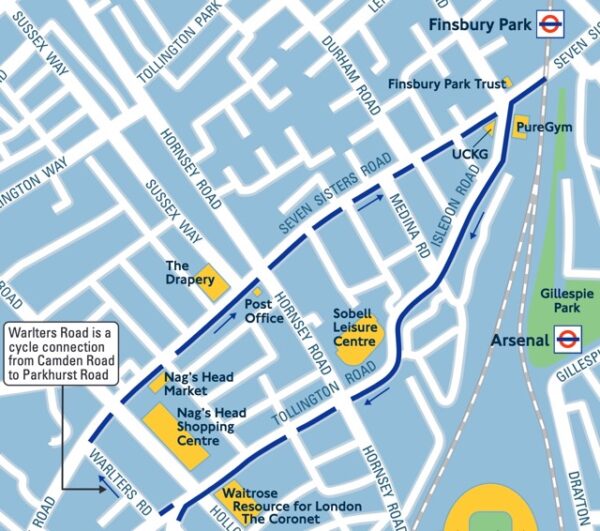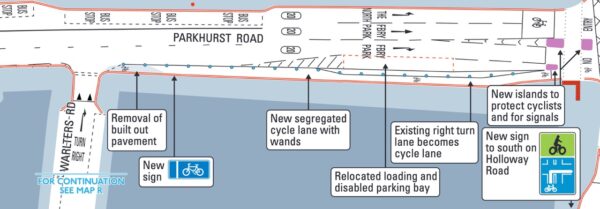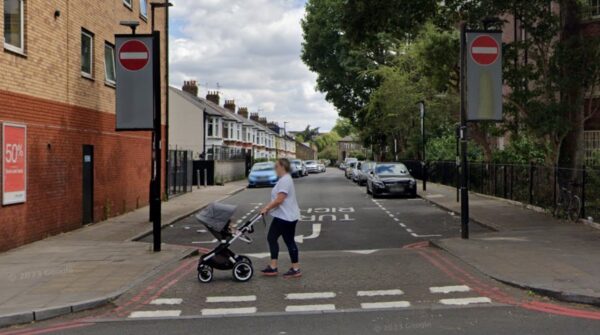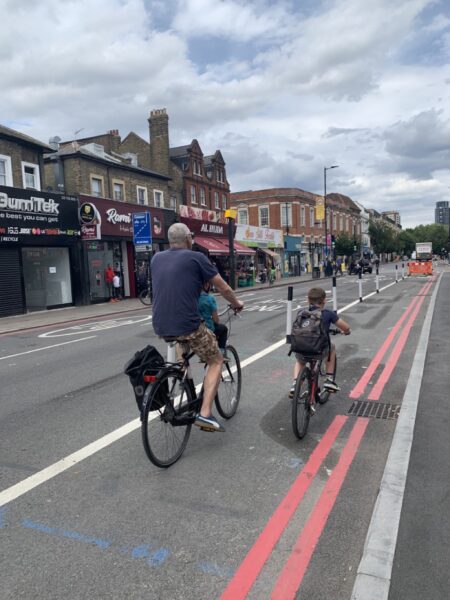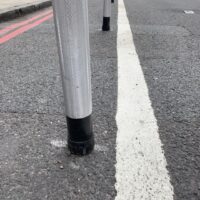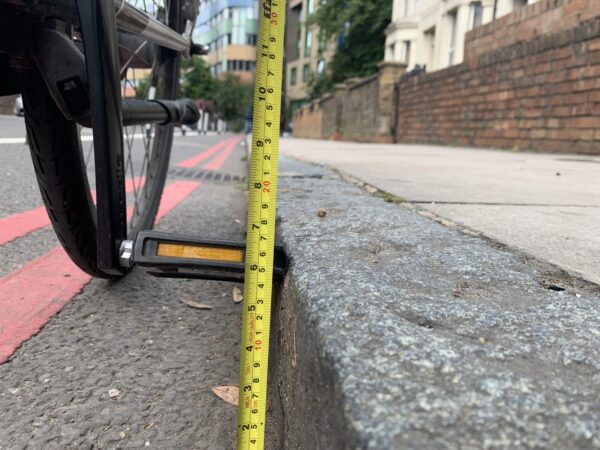Since February of 2023, TfL have been building the Islington portion of Cycleway 50 along the A503/Nag’s Head Gyratory. Work is slated to last through November 2023.
- TfL has a page explaining the project.
- Islington has a page for their piece of the work between Camden Rd and York Way.
- The designs have been placed on a handy Felt map by Will Petty.
Parkhurst Rd
The first piece of the project to be implemented was a short stretch of Parkhurst Rd/Holloway Rd junction.
It’s great to see a floated parking bay here with wand protection. Extending the eastbound track to Warlters Rd is essential, since eastbound cycles using C50 will approach from Warlters Rd. But there are two problems here that need to be addressed.
1. Entering the new track from the bus lane
It’s challenging to reach the cycle track from the bus lane:
Given this, most people cycling east in the bus lane will probably wait until Seven Sisters Road to take advantage of the new cycle lane. Those that do try to move over earlier will have to weave through traffic stacked up at the signals and blocking the Warlters Rd junction.
Ultimately, we’d like to see the eastbound track start at the Hillmarton Rd junction, if not further west. In this arrangement, it would be possible to provide signal time for bus lane cyclists to get safely and easily into the cycle lane. But since that seems unlikely in the near term, another solution is necessary here. Many hundreds of cyclists use Parkhurst Rd every day, and it’s just not acceptable in 2023 to build a cycle track without providing a way to access it for those who already cycle there.
2. Reaching C50 westbound from Parkhurst Rd
Cyclists who want to go west along C50 from this junction have to break the law by travelling southbound on Warlters Rd. The solution here is easy: Islington needs to designate Warlters Rd as bidirectional for cycles. There is plenty of space, and no safety reason to disallow cyclists to use this road southbound.
Seven Sisters Rd
The track along this stretch isn’t yet complete, but what is there is a huge step up from what was there before. In fact, families are already using the tracks to get around.
TfL is in the process of constructing the exit from the eastbound cycle track:
This is a good crossing which will separate bikes from cars using signals and a cycle reservoir. This design will also ensure that cyclists using the track will be positioned in front of traffic before going under the narrow rail bridge.
Isledon Rd/Tollington Rd
Lots of wands have been used to protect bikes from motor traffic on both sides of the gyratory. In the plans, these are placed on the cycle track lines, or just next to them. In real life, though, the wand placement varies wildly. Many are indented significantly from the lines for no reason. In some cases, and particlarly along the westbound stretch, this discrepancy has created a cycle track that’s actually narrower than the 1.5m minimum required by LCDS.
This is unfortunately the same stretch where the kerbs are quite high, significantly above the ~10cm allowed to prevent catching pedals.
This will make it difficult, if not impossible, for cyclists to pass one another in the lane. Fortunately, placing all wands on the painted lines is possible and should be inexpensive. TfL should make this change ASAP.
Takeaways
TfL has done a ton of work on the route already, and we can’t wait for it to be open! These active travel lanes are exactly what we mean when we say that highway authorities have to enable the broadest range of people to cycle. The lanes aren’t complete yet, but already the demand for them is clear. We’re confident that they will be a hit!
Still, there are important improvements to be made. We encourage TfL to do everything possible to address the shortcomings in the design and implementation quickly.


